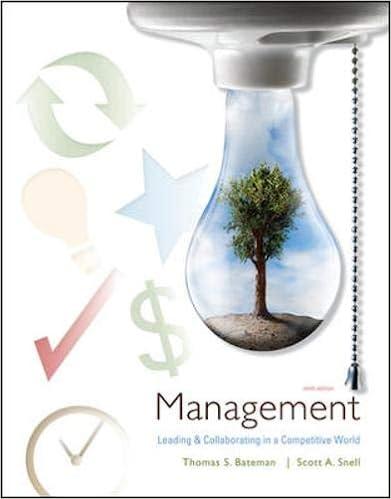Question
Anne Mulcahy is the ultimate loyal employee.She joined Xerox when she was 23 years old. She spent her first 16 years in sales, then 8
Anne Mulcahy is the ultimate loyal employee.She joined Xerox when she was 23 years old. She spent her first 16 years in sales, then 8 years in an assortment of management assignments - director of human resources, head of the company's fledging desktop computer business, and chief of staff to Xerox's CEO.. She never aspired to run Xerox, nor was she groomed to be the boss. So she was as surprised as anyone when Xerox's board chose her as CEO in August 2001. She accepted the job with mixed feelings: The company was in horrible financial shape.It has $17.1 billion in debt and only $154 million in cash. It was about to begin seven straight quarters of losses. The company had been slow to move from analogue to digital copying, and from black and white to colour. Japanese competitors like Canon and Ricoh had taken a large chunk of its market share in copying machines. Prior executives had diversified the company into financial services and never leveraged Xerox's expertise in personal computers. Xerox's stock price had dropped from nearly $64 in 2000 to $4.43.But Mulcahy felt a deep loyalty to the company. She felt an obligation to do everything in her power to save Xerox. Duty and loyalty compelled her to take a job that nobody else really wanted, despite the fact that she had zero preparation.
To say Mulcahy wasn't groomed for the CEO position is a true understatement. For instance, she didn't know financial analysis. She had no MBA and her undergraduate degree was in English/journalism.So she asked the company's director of corporate finance to give her a cram course in Balance Sheet 101. He helped her to understand debt structure, inventory trends and the impact of taxes and currency rates. This allowed her to see what .would generate cash and how each of her decisions would affect the balance sheet. Mulcahy says now that her lack of training had its advantages.She had no preconceived notions, no time to develop bad habits.
Mulcahy and her executive team faced a difficult task from the beginning. Xerox is an old-fashioned company, and people resisted change. The average tenure of a Xerox employee is 14 years, double the overall corporate average. Although everyone knew the company was in trouble, there wasn't a lot of willingness to challenge the conventional wisdom. She appealed to employees with missionary zeal, in videos and in person to "save each dollar as if it were your own". She rewarded those who stuck it out not only by refusing to abolish raises but with symbolic gestures as well; in 2002, for instance, she gave all employees their birthdays off. The gentle pressure was vintage Mulcahy: Work hard, measure the results, tell the truth, and be brutally honest.
After less than two years as CEO, Mulcahy has made startling progress in turning Xerox around. Employees appreciated her truthful and straightforward style. They also liked the fact that she was willing to work shoulder to shoulder with subordinates. Because she was working so hard, people felt obligated to work harder too. But Mulcahy is no softy. She's smart, energetic, and tough but compassionated. And she showed the ability to make hard decisions. For instance, she slashed costs in part by cutting Xerox's workforce by 30% and she shut down the desktop division. She oversaw the streamlining of production, new investment in research and development, and restructured the sales force so vague lines of authority became clear. She met with bankers and customers. Most importantly, she travelled. She galvanised "the troops" by visiting Xerox's offices - sometimes hitting three cities a day - and inspiring employees. Although many people were concerned that the company was headed for bankruptcy, she wouldn't consider that an option. By the summer of 2003, Xerox had had four straight quarters of operating profits. The company's stock was up to $11 a share. And while Xerox's future was still far from secure, at least it was beginning to look like the company would have a future.
Questions
- How did Anne Mulcahy create trust with employees after becoming CEO?
- Did Mulcahy have a vision for Xerox? Explain.
- What qualities do you think helped Mulcahy to affect the turnaround in Xerox?
- What does this case say about leadership experience?
Step by Step Solution
3.53 Rating (156 Votes )
There are 3 Steps involved in it
Step: 1
1 Anne Mulcahy created trust with employees after becoming CEO through several approaches Truthful and straightforward communication Mulcahy appealed ...
Get Instant Access to Expert-Tailored Solutions
See step-by-step solutions with expert insights and AI powered tools for academic success
Step: 2

Step: 3

Ace Your Homework with AI
Get the answers you need in no time with our AI-driven, step-by-step assistance
Get Started


